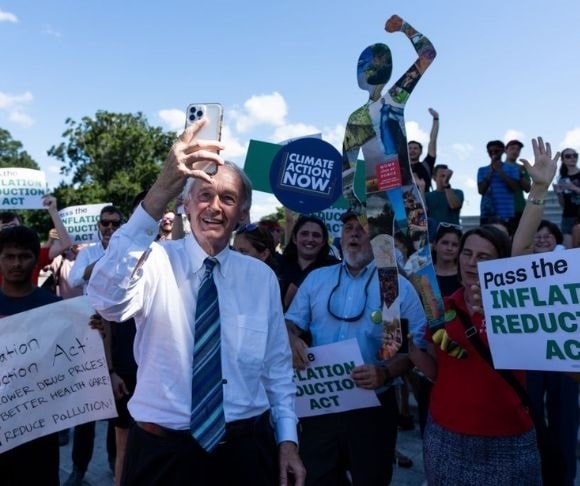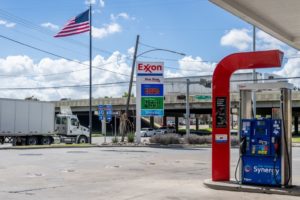
(Bill Clark/CQ-Roll Call, Inc via Getty Images)
The US inflation rate finally eased at a notable pace after more than a year of steady increases. But while Wall Street is celebrating the possibility of a so-called Fed pivot, the broad-based consumer price index (CPI) remained significantly elevated in July, hurting households nationwide. Any easing in the monthly snapshot of America’s cost of living situation was due to demand destruction rather than anything Washington embarked upon this summer. So, grab your wallet and find out what cost more and what hurt your pocketbook less to kick off the third quarter of 2022.
US Inflation Remains Elevated
 The US annual inflation rate tumbled to 8.5% in July, down from the whopping 9.1% increase in June, according to the Bureau of Labor Statistics (BLS). The core CPI, which strips the volatile food and energy sectors, was unchanged at 5.9%. On a monthly basis, the US inflation reading was flat at 0%, and the core inflation measurement rose 0.3%.
The US annual inflation rate tumbled to 8.5% in July, down from the whopping 9.1% increase in June, according to the Bureau of Labor Statistics (BLS). The core CPI, which strips the volatile food and energy sectors, was unchanged at 5.9%. On a monthly basis, the US inflation reading was flat at 0%, and the core inflation measurement rose 0.3%.
Despite the welcomed relief in the CPI, prices were significantly higher compared to a year ago. Here is a look at the BLS annualized figures:
- Food: +10.9%
- Energy: +32.9%
- New Vehicles: +10.4%
- Used Cars and Trucks: +6.6%
- Apparel: +5.1%
- Medical Care Commodities: +3.7%
- Shelter: +5.7%
- Transportation Services: +9.2%
- Medical Care Services: +5.1%
“Hardly a positive report, today’s CPI numbers show inflation is six times what it was when Biden took office. The Biden administration may think this is a political win, but it is a loss for American families,” said EJ Antoni, research fellow in regional economics with The Heritage Foundation’s Center for Data Analysis. So, if everything is up across the board and Americans are still hurting, why did the CPI reading sink?
Explaining the Decline
It was all about energy prices – particularly the cost of gasoline. The pain at the pump diminished by 7.6%, and fuel oil slumped 7.7% month-over-month. The average price for a gallon plummeting to approximately $4.

(Photo by Brandon Bell/Getty Images)
Before graduates of the School of Bidenomics begin championing the president’s efforts, the administration’s policies had nothing to do with the jaw-dropping slide. If it was not the intelligent economic mavens inside the White House who crafted measures to lower prices, what was the cause? Ostensibly, the cure for higher prices has been higher prices, with motorists staying home and altering their behaviors to adapt to this inflationary environment and recession economy.
In addition to the American Automobile Association (AAA) survey showing that people are driving less, combining errands, carpooling, and taking fewer leisure trips, government data show a build in gasoline stockpiles and a drop in demand. According to the US Energy Information Administration (EIA), gas supplies have risen by about eight million barrels over the last seven weeks, and demand has slumped by approximately one million barrels during this span.
The Red Dragon has also helped quite a bit over the last several months. China’s COVID Zero strategy forced investors to hit the sell button on West Texas Intermediate (WTI) and Brent crude oil futures as lockdowns and restrictions weighed on Beijing’s consumption levels.
Still, households paid more to keep the lights on as electricity ballooned by 1.6% month-over-month and 15.2% year-over-year.
Woe Is America?

(Photo by Liao Pan/China News Service via Getty Images)
Everyone is taking a victory lap after a lower-than-expected CPI. However, like the July jobs report, there is a lot to dig into underneath the surface. Compared to last year, consumers are paying 38% more for eggs, the cost of milk has advanced 15.6%, coffee has spiked 20.3%, rent is 5.8% more expensive, public transportation has spiked 19%, and health insurance has skyrocketed 20.6%. Suffice it to say, this era of four-decade high inflation is sticky, elevated, and not going away anytime soon. The consensus in April was that inflation peaked at 8.3% before climbing, and then it surged even higher. The August CPI will tumble again, but the US will only get a sense of what is happening on the price front in the fourth quarter.
Until then, it is essential to ask a few questions: Did mom-and-pop gasoline stations stop being greedy? Did Russia un-invade Ukraine? Did supermarket chains and food processors have a change of heart? Did the Republicans stop obstructing the president’s agenda? Remember, these were the excuses used for rampant inflation. So, with this logic, such events must have happened to halt the cost-of-living crisis.
Remember to check out the web’s best conservative news aggregator
Whatfinger.com — the #1 Alternative to the Drudge


